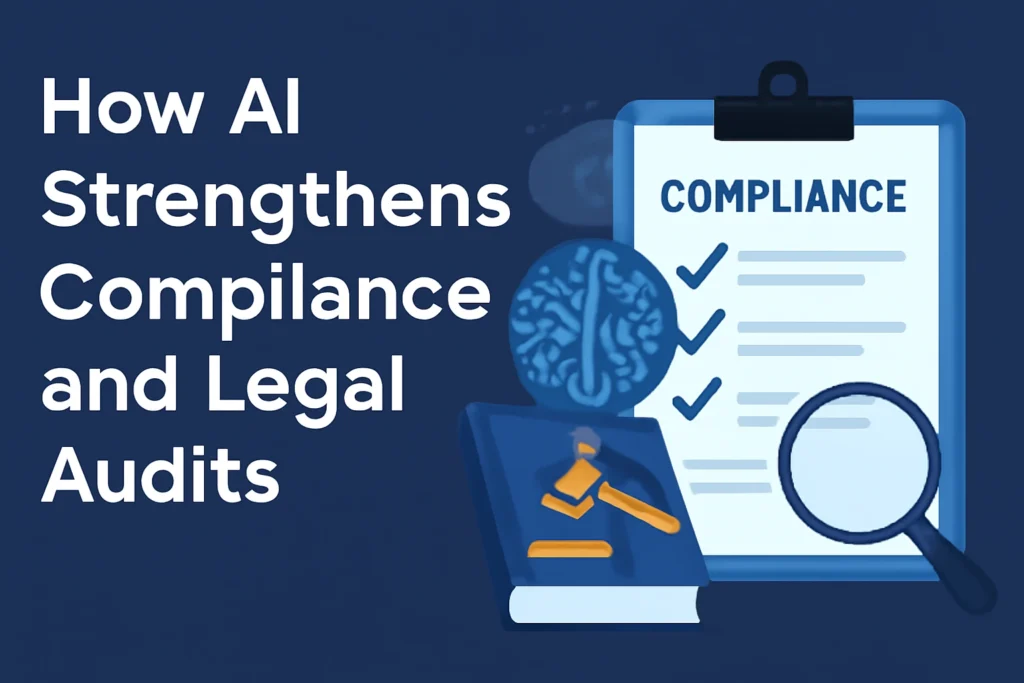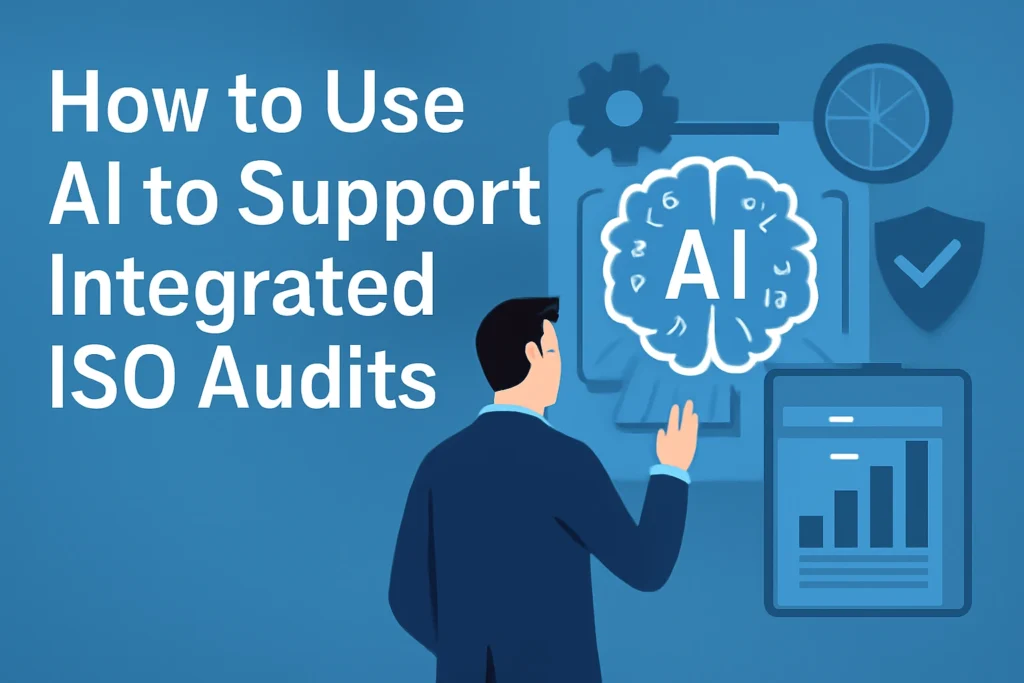Introduction to AI in Integrated ISO Audits
Integrated ISO audits bring multiple standards—such as ISO 9001 for quality management, ISO 14001 for environmental practices, and ISO 27001 for information security—into a single management system, reducing duplication and improving compliance. Learning how to use AI to support integrated ISO audits is transforming this process by analyzing large volumes of audit data, identifying non-conformities, and supporting continuous improvement within predictive risk management. AI-driven tools help internal audit teams streamline document reviews, automate corrective actions, and enhance overall efficiency, making quality management systems more adaptive, data-driven, and focused on continuous improvement.
Why Integrated ISO Audits Need AI Support
Integrated ISO audits align standards like ISO 9001, ISO 14001, and ISO 27001 within one management system, but learning how AI can streamline these processes can reduce delays and uncover missed insights. Artificial intelligence supports these audits by automating data analysis, highlighting non-conformities, and ensuring continuous compliance with specific ISO standards. AI tools strengthen internal audit teams by offering predictive risk assessment, real-time monitoring, and corrective action planning, enhancing the use of AI in ISO compliance. This integration not only enhances audit efficiency but also drives continuous improvement, helping organizations maintain quality management, meet regulatory expectations, and build stronger customer trust across multiple ISO standards.
Key Ways AI Enhances the ISO Audit Process
Automating Document Reviews and Version Control
AI automates document reviews and version control, keeping ISO 9001 records accurate and updated, thus facilitating the ISO certification process while adhering to best practices and standards set by ISO. This reduces errors, saves time, and strengthens compliance, demonstrating the benefits of artificial intelligence in ISO management.
Predictive Analytics for Non-Conformities
By analyzing historical audit data, AI predicts potential non-conformities and supports proactive corrective action, improving integrated ISO audit outcomes.
Continuous Monitoring & Real-Time Reporting
AI enables continuous monitoring and instant reporting, allowing organizations to detect risks faster and maintain compliance with ISO standards.
Enhancing Internal Audit Team Efficiency
Automation frees internal audit teams from repetitive tasks, helping them focus on value-driven analysis and continuous improvement in QMS, while learning how AI can optimize these processes.
AI Tools That Support Integrated ISO Audits
Natural Language Processing (for audit data analysis)
Natural Language Processing helps auditors quickly analyze audit reports, policies, and compliance documents, showcasing the use of AI in ISO assessments. By processing large volumes of text, NLP highlights non-conformities, ensures alignment with ISO standards, and saves valuable time in data analysis, illustrating how AI can monitor compliance.
Machine Learning Models (for risk prediction)
Machine learning models study historical audit data to detect patterns and predict risks, showcasing how AI can analyze trends effectively. These AI-driven insights enable proactive corrective actions, reducing the chances of repeated non-conformities in integrated ISO audits, thus supporting continuous improvement within the audit processes.
Tools like ChatGPT for Summaries & Gap Analysis
AI tools such as ChatGPT simplify internal audits by generating clear summaries, reviewing lengthy documents, and using data to identify gaps against ISO 9001 requirements.
AI Systems for Continuous Improvement
AI-powered systems provide continuous monitoring, recommend corrective actions, and support ongoing compliance with multiple ISO standards. This drives long-term improvements across quality management systems.
Comparing Traditional vs. AI-Powered ISO Audits
Integrated ISO audits become more efficient when artificial intelligence is applied. The table below highlights the difference between traditional auditing methods and AI-powered approaches, showing how technology enhances compliance, risk management, and continuous improvement within management systems.
| Feature | Traditional Audit | AI-Powered Integrated Audit |
|---|---|---|
| Document Review | Manual & Time-Consuming | Automated & Fast |
| Risk Identification | Based on Auditor Experience | Predictive AI Models |
| Compliance Checks | Static | Continuous Monitoring |
| Corrective Actions | After Audit Only | Real-Time Alerts |
| Data Analysis | Limited & Manual | Advanced & AI-Driven |
AI tools transform audits into proactive, data-driven processes, helping organizations maintain compliance and improve overall efficiency.
How AI Supports Corrective Actions and Continuous Improvement
Identifying Gaps Early with Predictive Models
AI analyzes historical audit data to predict non-conformities and identify gaps before they become major compliance issues, supporting timely corrective actions.
Driving Proactive Risk Management
Machine learning models and AI-driven analytics strengthen internal audits by highlighting potential risks, enabling organizations to act proactively rather than reactively, aligning with best practices.
Enhancing Customer Satisfaction Through Compliance
By ensuring ISO 9001 and related standards are consistently met, AI technologies improve compliance, enhance process efficiency, and ultimately build stronger customer trust in the intended use of AI.
How AI Strengthens Compliance and Legal Audits

Artificial intelligence not only optimizes ISO audits but also enhances legal and compliance processes. By automating document reviews, analyzing risk patterns, and tracking corrective actions, AI offers organizations the ability to maintain strict adherence to regulatory standards. Just as AI streamlines internal and external audits, companies can also explore how AI technologies can analyze data to make audits more efficient. how to get a credit card lawsuit dismissed quickly and safely To reduce legal complications and maintain smoother compliance processes, organizations can identify areas for improvement, reinforcing proactive risk management and operational efficiency across business systems.
Integrating AI with ISO 9001 and Related Standards
Alignment with Quality Management System (QMS)
AI supports ISO 9001 compliance by continuously analyzing processes and monitoring quality metrics. This integration ensures that corrective actions are timely, non-conformities are flagged early, and the QMS operates efficiently, supporting continuous improvement within the system.
Combining ISO 9001 with ISO 27001 for Information Security
By linking quality management with ISO 27001 standards, AI enhances internal audits and compliance checks, helping organizations secure sensitive data while maintaining operational efficiency.
ISO 42001 and AI in Emerging Standards
Emerging standards like ISO 42001 benefit from AI-driven insights, predictive analytics, and automated audit support, allowing organizations to adopt new governance frameworks seamlessly, thus aligning with ISO.
Leveraging AI Across Business Processes
Artificial intelligence extends beyond ISO audits to enhance overall business operations, integrating management systems for better performance. By analyzing data, automating repetitive tasks, and monitoring compliance, AI improves organizational efficiency and reduces risks. It supports continuous improvement, predictive analytics, and proactive decision-making, helping teams maintain high standards across departments. Companies looking to explore AI’s broader impact on audits, compliance, and operational performance can visit to learn how AI is reshaping their processes. Tech Radars for detailed guides, ensuring that AI integration drives sustainable efficiency and strengthens management systems across multiple organizational processes, aligning with best practices.
FAQs About Using AI in Integrated ISO Audits
How does AI help in identifying non-conformities during ISO audits?
AI analyzes audit data, detects patterns, and flags potential non-conformities, helping organizations identify areas to address issues proactively, aligning with specific ISO standards.
Can AI fully replace human auditors?
AI supports auditors but cannot fully replace human judgment; it enhances efficiency and accuracy in audits.
Which AI tools are best for integrated ISO audits?
Tools like ChatGPT, NLP platforms, and machine learning systems provide summaries, gap analysis, and predictive insights.
How does AI support continuous improvement in ISO 9001?
AI tracks metrics, monitors compliance, and suggests corrective actions, fostering ongoing improvement in quality management systems.
Is AI integration expensive for small businesses?
AI adoption can scale with organizational needs, offering cost-effective solutions suitable for small enterprises seeking ISO certification.
How does AI support compliance with multiple ISO standards?
AI enables integrated audits by monitoring multiple standards set by ISO, automating document checks, and providing real-time compliance insights, making the audits more efficient.
Conclusion
Artificial intelligence is transforming ISO audits by streamlining data analysis, automating compliance checks, and supporting predictive risk management. While AI enhances efficiency and accuracy, combining it with human expertise ensures that audit insights are interpreted correctly and corrective actions are effective. Integrating AI tools within quality management systems helps organizations maintain ISO 9001, ISO 14001, and ISO 27001 standards more efficiently, while continuously improving processes through the use of AI. By leveraging AI alongside skilled auditors, businesses can achieve better compliance, proactive risk management, and ongoing operational excellence across integrated ISO audits.


